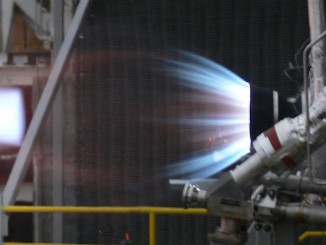
Blue Origin took another step towards the inaugural launch of its New Glenn rocket from Cape Canaveral Space Force Station. For the first time, the company placed a fully integrated, flight-capable rocket on the launch pad Thursday evening.
The company rolled the rocket out of the hangar at Launch Complex 36 (LC-36) earlier. A static fire test with the full 98-meter-tall (320 ft) rocket is forthcoming, though a specific date hasn’t been announced.
“Up we go! The steel launch table that New Glenn sits on weighs 1.7 million pounds (roughly 726 metric tons), including the clamps that connect to the vehicle’s aft ring,” said Dave Limp, Blue Origin CEO, in a social media post.
The upcoming integrated static fire test would be the first time that Blue Origin fuels a full-assembled. flight-ready New Glenn rocket. It previously conducted a static fire test of its upper stage, which saw a 15-second burn of the two BE-3U engines.
“We demonstrated its three key systems, including: the tank pressurization control system, which uses helium to pressurize the liquid hydrogen and liquid oxygen tanks during flight; the thrust vector control system, which gimbals the engines and steers the rocket during flight; and validated the start-up and shut-down sequences for the BE-3U systems, which can be restarted up to three times during a mission,” Blue Origin said in a September press release

With the Thanksgiving holiday less than a week away, the previously announced November launch date will more likely become December at the earliest. However, Blue Origin hasn’t issued a new target launch date either.
The original payload of the first New Glenn was originally planned to be NASA’s twin EscaPADE (Escape and Plasma Acceleration and Dynamics Explorers) satellites, which will be bound for Mars. However, due to delays in the rocket’s readiness, NASA decided that mission would be delayed until 2025.
Instead, Blue Origin said it will launch its Blue Ring technology, which it said offers “end-to-end services that span hosting, transportation, refueling, data relay, and logistics, including an ‘in-space’ edge computing capability.”
Back in March 2024, Blue Origin announced a mission called DarkSky-1 (DS-1), which is sponsored by the U.S. Department of Defense’s Defense Innovation Unit (DIU). Blue Origin said that mission was designed to “demonstrate Blue Origin’s flight systems, including space-based processing capabilities, telemetry, tracking and command (TT&C) hardware, and ground-based radiometric tracking.”
“The lessons learned from this DS-1 mission will provide a leap forward for Blue Ring and its ability to provide greater access to multiple orbits, bringing us closer to our vision of millions of people living and working in space for the benefit of Earth,” said Paul Ebertz, Senior Vice President of Blue Origin’s In-Space Systems, in a statement.
However, Blue Origin has yet to confirm if the Blue Ring flying on the NG-1 mission will be a fulfillment of the DS-1 mission. It said in its March 2024 statement that DS-1 “is expected to be launched co-manifested on the upper stage of a future National Security Space Launch.”
It’s not clear what the certification process is before New Glenn can fly national security missions. United Launch Alliance’s Vulcan rocket was asked to perform two successful certification flights to proceed with missions on behalf of the U.S. Space Force or the National Reconnaissance Office.

Big week for Blue Origin
Less than a day after rolling its orbital-class rocket to the pad, Blue Origin launched its ninth suborbital astronaut mission using its New Shepard rocket.
The mission, dubbed NS-28, lifted off from Launch Site 1 in near Van Horn, Texas, at 9:30 a.m. CST (1530 UTC). The crew capsule, named R.S.S. First Step, landed under the support of three parachutes at about 9:40 a.m. CST (1540 UTC) after reaching an apogee of 347,661 ft AGL (above ground level).
Among the six-member crew was engineer and STEM educator Emily Caladrelli, who made her first trip above the Karman Line, the internationally recognized boundary of space. By doing so, she became the 100th woman to journey to space.
After the flight, she spoke to a Blue Origin interviewer and exclaimed, “That kick in your pants from separation is wild. It is wild. I had to tell my brain, like, this is normal, like, this is expected, it’s supposed to be a kick in the pants.”
“Oh my gosh, and when we got to weightlessness, I immediately turned upside down and looked at the planet, and then there was so much blackness, there was so much space! I didn’t expect to see so much space!” Calandrelli said. “And I kept saying, like, that’s our planet (tearing up). That’s our planet. It was the same feeling I got when my kids were born, and I was like, that’s my baby, that’s my baby. And I like had that same feeling like where I’m seeing it for the first time. It was just beautiful (tears). Oh my God.”
We’ve just completed our ninth human spaceflight and the 28th flight of the #NewShepard program. The #NS28 crew included Emily Calandrelli, Sharon Hagle, Marc Hagle, Austin Litteral, James (J.D.) Russell, and Henry (Hank) Wolfond. Sharon and Marc Hagle both flew for the second… pic.twitter.com/nL1hG169QM
— Blue Origin (@blueorigin) November 22, 2024
Caladrelli was joined by Sharon and Marc Hagle, a philanthropic couple behind the organization, Space Kids Global, which is based in Orlando, Florida. This was their second flight aboard a New Shepard rocket.
Also onboard were three entrepreneurs: Austin Litteral, James Russell and Henry Wolfond. The six crew members experienced about three minutes of weightlessness before needing to return to their seats for the landing.
The mission marked Blue Origin’s 28th New Shepard launch. The company has s far launched 47 individuals, four of whom have flown to space twice, including company founder, Jeff Bezos.
Blue Origin doesn’t publicly advertise how much a seat onboard New Shepard costs.



